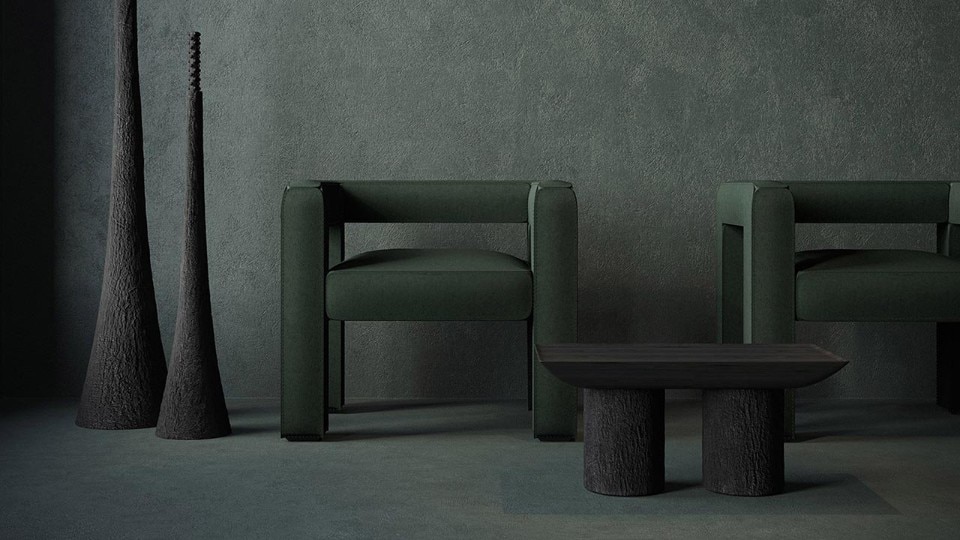Founded in Kiev by Victoria Yakusha in 2014, Faina Design is one of the exponents of the new minimalist collectible design. The sculptural character of her pieces merges with the rarefaction of her environments and a search for emotional resonance. For Yakusha, the possibility of interpreting this approach with originality is linked to the rediscovery of Ukrainian local traditions, the reappropriation of old artisan techniques and of ancient symbolic and cultural significance.
You describe your style as a form of "live minimalism" that expresses "laconicity and emphasis of feelings". Are these characteristics emerging from a social context or do they reflect your nature and your attitude as a designer?
Live minimalism is a combination of two of my biggest passions – nature and minimalistic approach. I always loved simple laconic forms, honest design that mercilessly cuts off all unnecessary things, creating an “emotionally clean” interior. When you combine that way of thinking with natural materials, endless power, beauty of diversity and imperfection, that teaches us nature, you have an original live minimalist style – no space for fakes or copies.

Faina claims a very strong bond with the Ukrainian craft tradition. How has this specific cultural legacy shaped your projects?
I am using local craft techniques for a contemporary sustainable design approach to emphasize the importance of connection to our cultural roots. It is true that Ukraine has century-old craft traditions, that only few people in the world know or ever heard about. Inside Ukraine, unfortunately, we also used to pay small attention to our roots for many years. When I started to discover crafts during my expedition to Ukrainian villages, museums of folk art, meeting with craft masters in 2014-2016, I realized the whole power of knowledge about materials, respectful usage of natural resources, reaches of shapes and symbols, that were encapsulates in crafts by so many generations. I decided to “give them a voice” and try to integrate crafts into contemporary design. In my tapestry collection, for example, I use some old Slavic symbols, which mean feminine energy and strength – the Tree of life, the Centre of Universe, the Goddess of Makosh, the Symbol of order. They add such a power to contemporary design, such a strong statement to the interior, that you can literally feel and it even if you don`t have Ukrainian roots and don’t really know what they mean.

One of your collection’s most peculiar features is the coating that distinguishes some pieces. What kind of technique is it?
Our organic line Ztista, which in Ukrainian means “made of dough” – is a great example of mixture between our past and future, traditions and futuristic vision. Ztista is made of recycled metal (steel) as a frame, covered with ecological primer to avoid corrosion, cellulose (recycled paper), linen, clay, wood chips and straw – it is definitely a piece of sustainable design, created with care for our planet. But we also collaborated here with local artisans who use a century-old craft technique, known as “valkuvannia”. It is a primitive rolling process, used a lot in a construction of Ukrainian huts, that involves the coating of a solid surface with a mixture of straw, hay and natural clay. I love this craft technique, because it keeps visible all the imperfections of the texture of the object, you can literally see fingerprints of it`s maker and reaches of its surface.
You recently presented at IDS Toronto the organic and 100% recycled furniture collection by Ztista. Is sustainability an issue you care about? How is it possible to implement it concretely, beyond easy labels?
Sustainable design is not only about the material, but also about “longevity” of the object at your home or even at home of next generations. We should carefully choose furniture for our homes, because our surroundings make a great impact on our health and wellbeing. I think that people in nearest future will radically change the way they pick furniture or lighting for their homes and offices, and they will choose them as “partners” or “friends” – by similar values and principles, not just style or color and with a long-life perspective. So, designers should create objects with that idea in their minds.

Your projects vary in scale, from object to interiors. Which are the latest interiors’ assignments you have completed? And the new projects you're currently working on?
Our recent interior project was a residential gallery in Brussels – Faina House. It is a 2-floor wood-frame family house which we turned into a cosy contemporary design gallery with a wide exposition of our live minimalist furniture and décor by Faina. The idea came long time ago, as we wanted to open our own showroom in Belgium, but make it home-style and welcoming, as if you were visiting old friends and, if necessary, could always stay over. We are currently working on the layout of a minimalist restaurant in Kiev, with a very interesting combination of organic materials, and an “Ethno-village” project in Europe, a complex of 22 eco-friendly houses with a carefully thought-out system of thermal protection, economical lighting, straw panels and roofs from natural reeds.
- Brand:
- Faina Design
- Designer:
- Victoria Yakusha
- Location:
- Kiev
Timeless icons: the Marenco sofa by arflex
Designed by Mario Marenco, this masterpiece of Italian design has set the standard for over fifty years.











